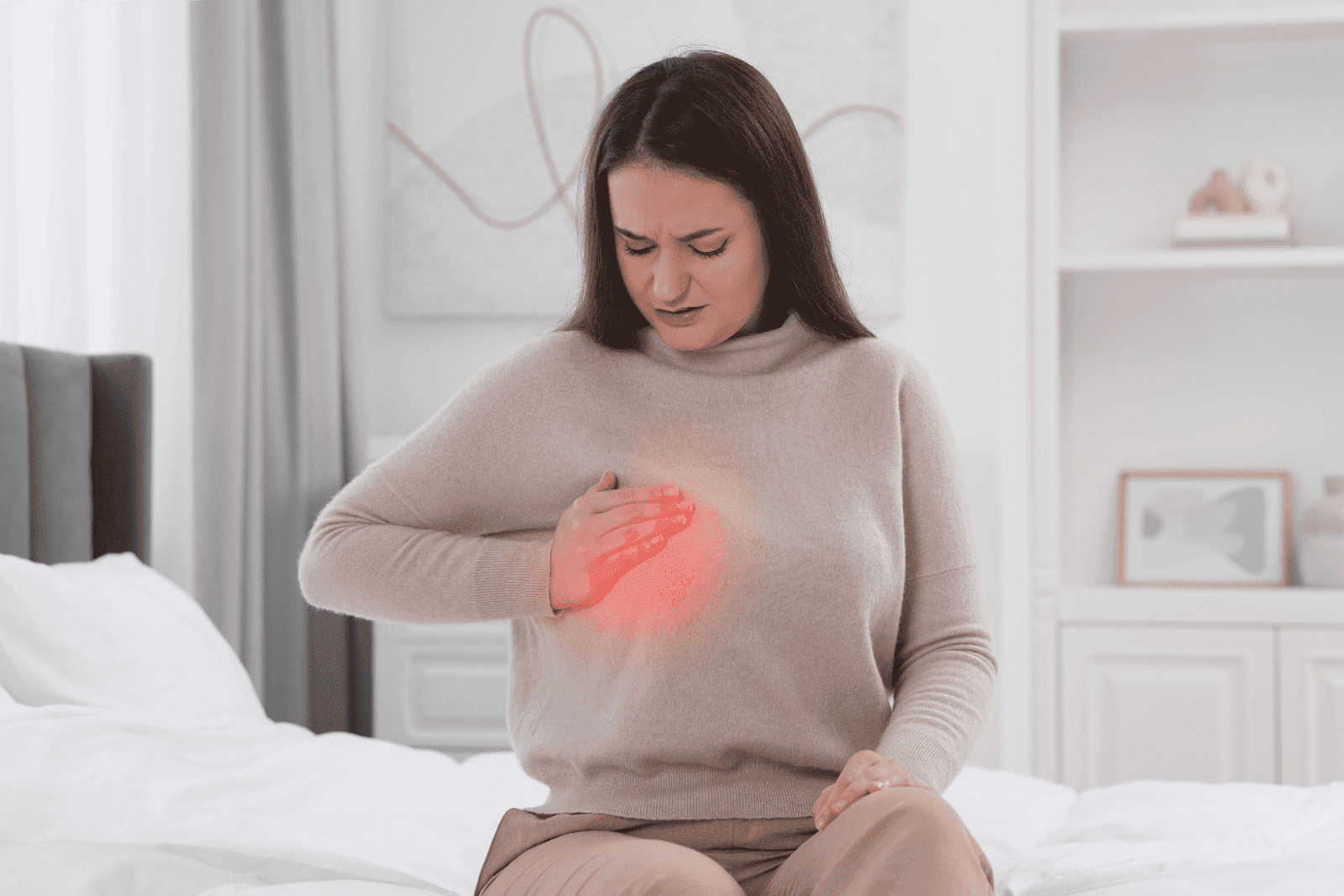Does Gabapentin Help with Sciatica?
Sciatica can cause sharp pain that shoots down your leg, making simple tasks hard. Many people wonder if gabapentin, a common medication, can ease this pain. This article [...]
Read More
Medically reviewed by Abhijit Bhattacharyya | MD, PhD, MBA, Tufts University School of Medicine - Miami, Florida on August 19th, 2025.
Breast pain, also called mastalgia, is a common complaint across all ages and body types. For many, the first instinct is alarm: could this be cancer? In reality, breast pain is rarely a sign of malignancy. Understanding the types of breast pain, common causes, and clear red flags can ease anxiety and guide effective action. This article walks through what to expect, when to seek immediate care, and how to get a timely evaluation, including convenient options like Doctronic.ai for fast, evidence-based guidance and affordable telehealth visits.
Breast pain affects a large portion of people with breast tissue at some point in life. Estimates suggest that a majority will experience breast tenderness or discomfort at least once, particularly during hormonal cycles, pregnancy, lactation, or after injury. Despite this prevalence, breast pain is an uncommon presentation of breast cancer. Large clinical reviews show that fewer than 1–2% of people evaluated for breast pain alone are diagnosed with breast cancer; pain without other concerning signs is rarely the only symptom.
The practical takeaway is that breast pain is usually not an emergency, but it should not be dismissed. Persistent, worsening, or accompanied symptoms deserve prompt evaluation. Quick, accessible answers can be obtained through telehealth tools such as Doctronic.ai, which offers free AI-driven visits and low-cost video appointments with licensed clinicians across all 50 states.
 Types of Breast Pain: Cyclical vs Noncyclical
Types of Breast Pain: Cyclical vs NoncyclicalBreast pain tends to fall into two broad categories: cyclical and noncyclical. Distinguishing between them helps determine likely causes and appropriate management.
Cyclical pain is related to the menstrual cycle and is the most common type among people of reproductive age. It typically affects both breasts, is described as a dull, heavy, or aching sensation, and increases in the luteal phase (the week or two before a period). Hormone fluctuations, particularly estrogen and progesterone, are the usual drivers. Cyclical pain often improves after menstruation and may respond to lifestyle measures and over-the-counter pain relief.
Noncyclical pain is unrelated to the menstrual cycle and can be localized to one breast or even a single spot. Causes are more varied and include trauma, infection, cysts, musculoskeletal issues (like costochondritis), and rarely malignancy. Pain that is constant, sharp, or focused in one area is more likely to be noncyclical and may require targeted evaluation.
Understanding common causes clarifies why most breast pain is benign. A few frequent culprits are listed below.
Hormone-driven changes to the breast tissue, described as fibrocystic change, are very common. This can cause lumpiness, tenderness, and aching that vary with the cycle. Pain tends to be bilateral and diffuse rather than focal.
Fluid-filled cysts or benign solid lumps like fibroadenomas can cause localized soreness, especially if a cyst enlarges or leaks. Ultrasound is often used to distinguish these from solid masses.
In breastfeeding people, mastitis and breast abscesses are important causes of pain and typically present with localized redness, swelling, and systemic symptoms like fever. Prompt treatment with antibiotics and sometimes drainage is essential.
Pain from the chest wall, ribs, or shoulder, costochondritis, or muscle strain, can feel like breast pain. Referred pain from heartburn or cardiac issues may also be perceived in the chest or breast area. A careful history and physical exam usually identifies these sources.
Direct injury, biopsies, or surgery can cause lingering breast pain. In many cases, the discomfort gradually improves, but persistent pain after an injury merits follow-up.
Most breast pain can be evaluated within a reasonable outpatient timeframe, but certain symptoms should prompt quicker medical contact or urgent care:
A new, hard, immovable lump or thickening that is persistent and focal.
Any nipple discharge that is bloody or spontaneous (not expressed).
Rapidly spreading skin changes: dimpling, puckering, or an “orange peel” (peau d’orange) appearance.
Red, hot, swollen areas of the breast accompanied by fever, possible mastitis or abscess.
Unexplained weight loss, night sweats, or other systemic signs alongside breast changes.
Severe, worsening pain that limits daily activities or sleep despite simple measures.
Evaluation begins with a thorough history and physical examination. Key details include the location, quality, timing, and triggers of the pain; association with menstrual cycles; history of trauma; breastfeeding status; and any accompanying symptoms.
Depending on findings, clinicians may recommend imaging. For those under 30, a breast ultrasound is often the first test to characterize masses or cysts. For people 30 and older, diagnostic mammography with targeted ultrasound is typical. If infection is suspected, blood tests and culture from any discharge may be obtained. Rarely, a biopsy is recommended for persistent focal masses that appear suspicious on imaging.
Many people find meaningful relief from conservative measures that are safe and easy to try first.
Wearing a well-fitted, supportive bra (including during exercise) can reduce mechanical discomfort. For some, soft-cup bras or sports bras provide the best comfort. Cold compresses, supportive wrapping during activities, and avoiding tight clothing that rubs the breast can also help.
Over-the-counter nonsteroidal anti-inflammatory drugs (NSAIDs), such as ibuprofen or naproxen, reduce inflammation and pain. Acetaminophen is an alternative for those who cannot take NSAIDs. Topical analgesics may offer short-term relief for localized soreness.
Some find that reducing caffeine intake or limiting high-fat and salty foods around the time of menses helps cyclical symptoms. Evidence for supplements like evening primrose oil or vitamin E is mixed; benefits are modest and inconsistent across studies. Always check with a clinician before starting new supplements, particularly during pregnancy or when taking other medications.
When pain is severe or persistent despite conservative care, hormonal interventions (combined oral contraceptives, progesterone modulation) or specific medications like topical tamoxifen or, in selected cases, oral danazol, may be considered. These are prescribed and monitored by clinicians experienced in managing breast symptoms.
Certain life stages change the causes and urgency of breast pain.
During pregnancy, breast tissue undergoes significant hormonal changes that commonly cause fullness, tenderness, and sensitivity. In the postpartum period, breastfeeding-related issues, such as plugged ducts, mastitis, or abscesses, can cause intense pain and systemic symptoms. Fever, spreading redness, or signs of an abscess require urgent evaluation.
Men can experience breast pain from gynecomastia (hormone-related breast enlargement), trauma, infections, or, rarely, male breast cancer. Any lump or persistent localized pain in a man’s breast should prompt evaluation.
Imaging is guided by age and exam findings. Ultrasound is preferred for younger patients and is excellent for differentiating cysts from solid masses. Mammography is more sensitive in older patients or when there are focal abnormalities. If imaging shows a suspicious area, or if a mass persists after a benign imaging result, tissue sampling (core needle biopsy) may be recommended to rule out malignancy.
A reasonable, practical approach helps avoid unnecessary panic while ensuring serious conditions aren’t missed:
If pain is cyclical, diffuse, and mild, try conservative measures for one to two cycles. If improvement occurs, continue supportive care.
If pain is localized, new, or associated with a palpable lump, seek evaluation within days to a few weeks.
If pain is accompanied by skin changes, bloody nipple discharge, fever, or rapid progression, seek urgent evaluation that day or within 24 hours.
Telehealth is excellent for triage, history-taking, and guidance on next steps. Many services provide quick access to clinicians who can determine if immediate in-person imaging or urgent care is required. Doctronic.ai offers free AI-driven visits that can summarize likely causes and recommend whether a video visit or in-person evaluation is needed. For people seeking a clinician visit, Doctronic also provides affordable telehealth video appointments with licensed doctors 24/7 across all 50 states for under $40.
Telehealth cannot replace imaging. If a clinician suspects a mass, redness suspicious for infection, or other red flags, they will direct the patient to in-person imaging or urgent care for physical examination, ultrasound, or mammography. Note that Doctronic does not provide a list of urgent care locations, but clinicians can advise whether urgent local evaluation is indicated and what to request at the visit.
Bring a clear description of the pain: onset, duration, triggers, and any breast changes. Note menstrual history, recent injuries, breastfeeding status, and family history of breast cancer. If possible, photograph any visible skin changes to share with the provider. During imaging appointments, mention focal areas of tenderness so technologists can target the exam for the most useful information.
While not all breast pain is preventable, certain habits help reduce frequency and intensity. Maintain a well-fitted, supportive bra, especially during exercise. Manage stress and sleep, since hormonal balance affects breast sensitivity. Regular physical activity and a balanced diet that moderates caffeine and alcohol intake can help some people. Routine screening mammography should be followed as recommended based on age and risk factors.
If breast pain is severe, persistent despite treatment, or associated with complex imaging findings, referral to a breast specialist or surgeon is appropriate. A breast specialist can coordinate advanced imaging, perform targeted biopsies if needed, and offer longer-term management options, including hormonal therapies and pain specialists if necessary.
 Using Doctronic.ai for Fast, Evidence-Based Guidance
Using Doctronic.ai for Fast, Evidence-Based GuidanceWhen breast pain raises questions but immediate in-person care is not clearly required, Doctronic.ai can be a fast, user-friendly resource. The AI-driven service synthesizes peer-reviewed medical literature to provide a clear, evidence-based initial assessment; it also offers low-cost video visits with licensed clinicians 24/7 across the United States for follow-up and prescriptions if needed. Whether the need is reassurance, triage, or arranging next steps like imaging, Doctronic.ai connects users to appropriate care quickly.
Breast pain is common and usually not a sign of cancer, particularly when it is cyclical and diffuse. Red flags, focal hard lumps, bloody nipple discharge, rapid skin changes, fever with redness, or persistent localized pain, warrant timely medical evaluation. Simple self-care measures, proper support, and over-the-counter pain relief help most people. Telehealth services like Doctronic.ai can provide fast, evidence-based triage and convenient follow-up; when imaging or in-person care is indicated, clinicians will guide the next steps to ensure safe and thorough evaluation.
Persistent worry about breast symptoms is understandable. Getting clear, evidence-based guidance quickly reduces anxiety and helps get the right care at the right time. For an immediate assessment or to schedule an affordable telehealth visit, visit Doctronic.ai or start a free AI-driven consultation to learn whether urgent care or imaging is needed.
When you’re unsure whether breast pain needs urgent care, start with Doctronic, the #1 AI Doctor that over 10 million people trust. Our free AI-driven visits synthesize the latest peer-reviewed medicine to give clear, evidence-based triage and recommendations you can take to any clinician, and if you need a provider, affordable video visits with our licensed doctors are available 24/7 in all 50 states for under $40. Skip the line. Talk to an AI Doctor Now, for free.
Sciatica can cause sharp pain that shoots down your leg, making simple tasks hard. Many people wonder if gabapentin, a common medication, can ease this pain. This article [...]
Read MoreBack pain is one of the most common health complaints, affecting millions of people worldwide. If you have back pain, you might have heard about gabapentin as a possible [...]
Read MoreIf you take gabapentin, you might wonder if it will show up on a drug test. This question matters for many people, whether it’s for work, sports, or legal reasons. Gabapentin [...]
Read More